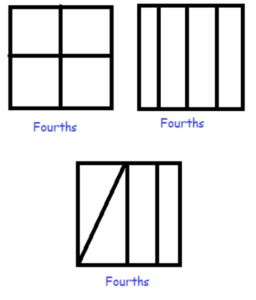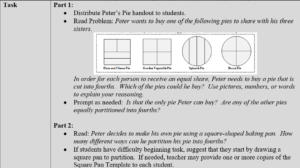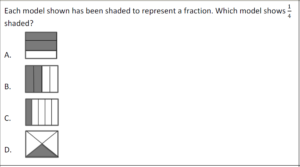Partition shapes into parts with equal areas. Express the area of each part as a unit fraction of the whole. For example, partition a shape into 4 parts with equal area, and describe the area of each part as 1/4 of the area of the shape.
[divider] [/divider] Students are able to…
- Draw shapes and partition them into equal parts.
- Understand that equal parts have the same area.
- Identify the number of parts a shape is partitioned into and describe using fractional names.
[divider] [/divider] Students are able to…because teachers:
- Provide students with a variety of shapes to partition into equal parts.
- Model precise vocabulary when describing unit fractions.
- Provide opportunities for the students to share their understanding of partitioning shapes
[divider] [/divider] Questions to ask students:
- Can you show me more than one way to split a square into fourths?
- Sample answer that indicates understanding:
- Draw a circle split into three equal pieces and ask students to describe the fractional name.
- Sample answer that indicates understanding: This circle is divided into three equal parts. Each part is one-third of the circle.
[divider] [/divider] FSA Notes
Cognitive Complexity Level: 1 – Recall
Achievement Level Descriptors:
2- identifies that the numerator is the number of equal parts being considered; identifies that the denominator is the number of equal parts that make up the whole
3- partitions a shape in multiple ways to show understanding that 1/b is equal to one part when the whole is partitioned into b equal parts; shows the fraction a/b as the quantity formed of a parts of 1/b
4- partitions a shape in multiple ways to show understanding that 1/b is equal to one part when the whole is partitioned into b equal parts; shows the fraction greater than 1, a/b, as the quantity formed of a parts of 1/b
5- [intentionally left blank]
Assessment Limits:
Denominators are limited to 2, 3, 4, 6, and 8.
Items are limited to combining or putting together unit fractions rather than formal addition or subtraction of fractions.
Maintain concept of a whole as one entity that can be equally partitioned in various ways when working with unit fractions.
Fractions a/b can be fractions greater than 1.
Items may not use the term “simplify” or “lowest terms” in directives.
Items may not use number lines.
Shapes may include: quadrilateral, equilateral triangle, isosceles triangle, regular hexagon, regular octagon, and circle.
[divider] [/divider] Additional Resources:
Additional in depth content knowledge
Blog Post: Understanding Fractions with an Area Model
Video: Partition a Shape into Equal Shares
[divider] [/divider] Sample Formative Assessment Task:


